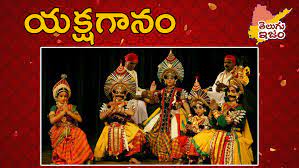Yakshaganam : Considered the oldest of the ancient art forms and has spread widely in Andhra Pradesh, Tamil Nadu, and Karnataka. It is a composite art form that incorporates elements of dance, drama, music, costumes, language, and decorations. It holds significant cultural and artistic importance in Karnataka.
The evolution of Yakshagana has witnessed changes in its writing and performance styles from one generation to another. Initially, performances took place in Yatra places and Kamandula places, and later in rural settings such as Ratchasavidi and Rachadevidis.
In the present day, Yakshagana can be performed on any stage, be it in a person’s house or in front of a rich household, often under a constructed canopy known as Katikanela on open land.
Yakshaganam Consists
Yakshagana predominantly revolves around mythological stories. Performances usually commence in the evening, with drum beats preceding the start of the show to inform the village.
The actors dress in vibrant attire, with painted faces and headgear. These performances primarily depict legends, with a narrator telling the story while music plays in the background.
The actors and actresses perform dances according to the descriptions, while dialogue is minimal. Yakshagana continues until sunrise the following day. The art form has been referred to by various names such as Kelike, Ata, Bayalata, and Dashavatara over the past 200 years.
In Yakshagana, stories are selected and presented to the audience through singing, acting, and dancing. Such chosen stories are known as “Upakhyana” in Kannada.
For example, if the story of the war between Bhima and Duryodhana from the Mahabharata is selected, it is called “Gadaiuddha Upakhyana.” Yakshagana narratives need not be exclusively mythological; they can also encompass historical or social themes.
The actors or dancers who portray the characters in the narratives are called “Bhagavataru.” They are responsible for engaging the audience through their dance, acting, and clever dialogues. Each character speaks for themselves during the performance. The Bhagavataru, who leads the singing, plays a vital role in Yakshagana. They melodiously sing the story in the form of a song, while the other characters perform synchronized dances in response to the song’s meaning, expressing various emotions.
The background music, known as “Himmela,” is crucial during Yakshagana performances. The band provides musical support using instruments such as drums, maddela, mridanga, and jaghanta. The background music, along with the performance of the characters and the melody of the Bhagavatar, contributes to the success of a Yakshagana performance.
One popular form of Yakshagana is “Bayalata” or “Vedi Bhagotham.” It involves performances on open ground using elaborate costumes. It earned the name “Bayalata” because it is typically performed throughout the night in the open spaces (bayalu) of villages during festivals and celebrations.
Humor is a common element in Yaksha songs, and traditional Yaksha characters like Katakam Vadu, Singi Singadu, and Sunkara Kondadu have remained popular in the hearts of the people. Some Yakshaganas provide insights into various aspects of public life, including social customs, manners of speech, professions, and clothing, offering a glimpse into different classes and their ways of life. Romantic humor is often conveyed through a language that is accessible to all. Yakshaganas of the past served as ideal role models for kings and the general public, capturing their imagination and admiration.
Also Read : Buttabommalu : A Cultural & Significance In Captivating Audiences

